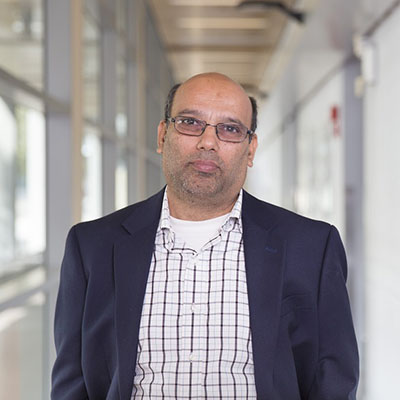
Farhat Beg
Research
The High Energy Density Physics Group at UCSD has been pursuing an experimental research on fast ignition (FI) inertial confinement fusion (ICF), laser matter interactions, wire array z-pinches, x-pinches and neutron sources. The group has a strong simulation component and has an access to Particle-in-Cell (LSP and PICLS), radiation-hydrodynamic (Hydra and h2d) and Magneto-Hydrodynamic (MHD) codes. These codes are used to design and interpret experiments carried out both at National Laboratories and other user facilities, and also in the HEDP laboratory at UCSD.
The HEDP Group has been involved in the study of relativistic electron beam transport through solid and warm dense targets. The relativistic electron beam is produced in high intensity laser matter interactions. The collimation and efficient transport of the beam is critical to the success of FI.
FI is a special approach to ICF in which the energy to heat the fuel comes from a separate laser, rather than from the implosion process. This allows for the fuel to be heated more efficiently. It is quite inefficient to heat fuel by the process of implosion. There are a number of approaches to FI that are under current study. The one that HEDP group is primarily involved in, is that known as ‘Re-entrant cone guided FI’. In this approach a small gold cone is imbedded into the side of the spherical fuel capsule, providing a clear pathway to the central region where the compressed fuel globule is formed. The ultraintense laser that ignites the fuel is fired into the cone. Where it interacts with the cone tip an enormous number of extremely energetic electrons are generated. These electrons fly out into the fuel; heating it to the temperatures required for fusion.
The HEDP group also studies all aspects of x-pinches, z-pinches and wire arrays driven by compact pulsed power devices. These experiments are of interest as highly dynamic plasma objects and high flux, compact x-ray sources, and also in their application to ICF and Inertial Fusion Energy (IFE).
The study of ablation of wires in these various configurations is a subject of particular interest to the research community, in light of its strong effect on the evolution of the plasma structure. The HEDP group designs and conducts experiments to investigate specific areas of the ablation process in wire arrays and thin liners. These are carried out on an 80kA Marx driven pulser, and the 250kA GenASIS linear transformer driver (LTD). The data from these studies enables to more fully understand the fundamental properties of ablated plasma structures, and determine the physical mechanisms driving their behavior.
Furthermore, HEDP group studies supersonic jet formation extensively for its application to astrophysical phenomenon and their interaction with the interstellar medium and other objects.
Linkedin – https://www.linkedin.com/in/farhat-beg-87baa550
Bio
Farhat Beg received his Ph.D. degree in plasma physics from Imperial College, London, where he was a Research Associate and then a Research Fellow. In 2003, he joined the Department of Mechanical and Aerospace Engineering at the University of California, San Diego, where he is currently the Vice Chair and a Professor of engineering physics. He has published 170 articles in high quality journals—including Nature, Nature Physics, and Physical Review Letters—and has been cited more than 4700 times in peer refereed journals. Dr. Beg has been fellow of the American Physical Society since 2009 and the Institute of Electronics and Electrical Engineers (IEEE) since 2011. He received the Department of Energy’s Early Career Award in 2005 and the IEEE Early Achievement Award in 2008.